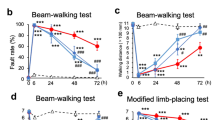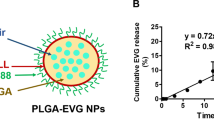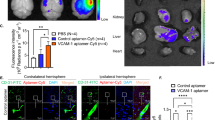Abstract
Chemokine receptor 5 (CCR5) is one of the main co-receptors of HIV-1, and has been found to be a potential therapeutic target for stroke. Maraviroc is a classic CCR5 antagonist, which is undergoing clinical trials against stroke. As maraviroc shows poor blood-brain barrier (BBB) permeability, it is of interest to find novel CCR5 antagonists suitable for neurological medication. In this study we characterized the therapeutic potential of a novel CCR5 antagonist A14 in treating ischemic stroke mice. A14 was discovered in screening millions compounds in the Chemdiv library based on the molecular docking diagram of CCR5 and maraviroc. We found that A14 dose-dependently inhibited the CCR5 activity with an IC50 value of 4.29 μM. Pharmacodynamic studies showed that A14 treatment exerted protective effects against neuronal ischemic injury both in vitro and vivo. In a SH-SY5Y cell line overexpressing CCR5, A14 (0.1, 1 μM) significantly alleviated OGD/R-induced cell injury. We found that the expression of CCR5 and its ligand CKLF1 was significantly upregulated during both acute and recovery period in focal cortical stroke mice; oral administration of A14 (20 mg·kg−1·d−1, for 1 week) produced sustained protective effect against motor impairment. A14 treatment had earlier onset time, lower onset dosage and much better BBB permeability compared to maraviroc. MRI analysis also showed that A14 treatment significantly reduced the infarction volume after 1 week of treatment. We further revealed that A14 treatment blocked the protein-protein interaction between CCR5 and CKLF1, increasing the activity of CREB signaling pathway in neurons, thereby improving axonal sprouting and synaptic density after stroke. In addition, A14 treatment remarkably inhibited the reactive proliferation of glial cells after stroke and reduced the infiltration of peripheral immune cells. These results demonstrate that A14 is a promising novel CCR5 antagonist for promoting neuronal repair after ischemic stroke.

A14 blocked the protein-protein interaction between CKLF1 and CCR5 after stroke by binding with CCR5 stably, improved the infarct area and promoted motor recovery through reversing the CREB/pCREB signaling which was inhibited by activated CCR5 Gαi pathway, and benefited to the dendritic spines and axons sprouting.
This is a preview of subscription content, access via your institution
Access options
Subscribe to this journal
Receive 12 print issues and online access
$259.00 per year
only $21.58 per issue
Buy this article
- Purchase on Springer Link
- Instant access to full article PDF
Prices may be subject to local taxes which are calculated during checkout






Similar content being viewed by others
References
Collaborators GBDS. Global, regional, and national burden of stroke and its risk factors, 1990-2019: a systematic analysis for the Global Burden of Disease Study 2019. Lancet Neurol. 2021;20:795–820.
Collaborators GBDCoD. Global, regional, and national age-sex-specific mortality for 282 causes of death in 195 countries and territories, 1980-2017: a systematic analysis for the Global Burden of Disease Study 2017. Lancet. 2018;392:1736–88.
Lin DJ, Finklestein SP, Cramer SC. New directions in treatments targeting stroke recovery. Stroke. 2018;49:3107–14.
Joy MT, Ben Assayag E, Shabashov-Stone D, Liraz-Zaltsman S, Mazzitelli J, Arenas M, et al. CCR5 is a therapeutic target for recovery after stroke and traumatic brain injury. Cell. 2019;176:1143–57.e13
Tan Q, Zhu Y, Li J, Chen Z, Han GW, Kufareva I, et al. Structure of the CCR5 chemokine receptor-HIV entry inhibitor maraviroc complex. Science. 2013;341:1387–90.
Villanueva MT. Repurposing CCR5 inhibitors for stroke recovery. Nat Rev Drug Discov. 2019;18:253.
Han W, Lou Y, Tang J, Zhang Y, Chen Y, Li Y, et al. Molecular cloning and characterization of chemokine-like factor 1 (CKLF1), a novel human cytokine with unique structure and potential chemotactic activity. Biochem J. 2001;357:127–35.
Dunne PD, O’Reilly PG, Coleman HG, Gray RT, Longley DB, Johnston PG, et al. Stratified analysis reveals chemokine-like factor (CKLF) as a potential prognostic marker in the MSI-immune consensus molecular subtype CMS1 of colorectal cancer. Oncotarget. 2016;7:36632–44.
Kong LL, Wang ZY, Han N, Zhuang XM, Wang ZZ, Li H, et al. Neutralization of chemokine-like factor 1, a novel C-C chemokine, protects against focal cerebral ischemia by inhibiting neutrophil infiltration via MAPK pathways in rats. J Neuroinflammation. 2014;11:112.
Chen C, Chu SF, Ai QD, Zhang Z, Chen NH. CKLF1/CCR5 axis is involved in neutrophils migration of rats with transient cerebral ischemia. Int Immunopharmacol. 2020;85:106577.
Clarkson AN, Huang BS, Macisaac SE, Mody I, Carmichael ST. Reducing excessive GABA-mediated tonic inhibition promotes functional recovery after stroke. Nature. 2010;468:305–9.
Yang Y, Wang ZH, Jin S, Gao D, Liu N, Chen SP, et al. Opposite monosynaptic scaling of BLP-vCA1 inputs governs hopefulness- and helplessness-modulated spatial learning and memory. Nat Commun. 2016;7:11935.
Shen Y, Zhou M, Cai D, Filho DA, Fernandes G, Cai Y, et al. CCR5 closes the temporal window for memory linking. Nature. 2022;606:146–52.
Norskov-Lauritsen L, Thomsen AR, Brauner-Osborne H. G protein-coupled receptor signaling analysis using homogenous time-resolved Forster resonance energy transfer (HTRF(R)) technology. Int J Mol Sci. 2014;15:2554–72.
Zhou M, Greenhill S, Huang S, Silva TK, Sano Y, Wu S, et al. CCR5 is a suppressor for cortical plasticity and hippocampal learning and memory. Elife. 2016;5:e20985.
Clarkson AN, Overman JJ, Zhong S, Mueller R, Lynch G, Carmichael ST. AMPA receptor-induced local brain-derived neurotrophic factor signaling mediates motor recovery after stroke. J Neurosci. 2011;31:3766–75.
Zhou X, Zhang YN, Li FF, Zhang Z, Cui LY, He HY, et al. Neuronal chemokine-like-factor 1 (CKLF1) up-regulation promotes M1 polarization of microglia in rat brain after stroke. Acta Pharmacol Sin. 2022;43:1217–30.
Joy MT, Carmichael ST. Learning and stroke recovery: parallelism of biological substrates. Semin Neurol. 2021;41:147–56.
Li S, Overman JJ, Katsman D, Kozlov SV, Donnelly CJ, Twiss JL, et al. An age-related sprouting transcriptome provides molecular control of axonal sprouting after stroke. Nat Neurosci. 2010;13:1496–504.
Overman JJ, Clarkson AN, Wanner IB, Overman WT, Eckstein I, Maguire JL, et al. A role for ephrin-A5 in axonal sprouting, recovery, and activity-dependent plasticity after stroke. Proc Natl Acad Sci USA. 2012;109:E2230–9.
Han X, Lv G, Wu H, Ji D, Sun Z, Li Y, et al. Biotinylated dextran amine anterograde tracing of the canine corticospinal tract. Neural Regen Res. 2012;7:805–9.
Caracciolo L, Marosi M, Mazzitelli J, Latifi S, Sano Y, Galvan L, et al. CREB controls cortical circuit plasticity and functional recovery after stroke. Nat Commun. 2018;9:2250.
Lorenzen E, Ceraudo E, Berchiche YA, Rico CA, Furstenberg A, Sakmar TP, et al. G protein subtype-specific signaling bias in a series of CCR5 chemokine analogs. Sci Signal. 2018;11:eaao6152.
Kim JY, Park J, Chang JY, Kim SH, Lee JE. Inflammation after ischemic stroke: the role of leukocytes and glial cells. Exp Neurobiol. 2016;25:241–51.
Rossi D, Zlotnik A. The biology of chemokines and their receptors. Annu Rev Immunol. 2000;18:217–42.
Shi K, Tian DC, Li ZG, Ducruet AF, Lawton MT, Shi FD. Global brain inflammation in stroke. Lancet Neurol. 2019;18:1058–66.
Zhu YM, Lin L, Wei C, Guo Y, Qin Y, Li ZS, et al. The key regulator of necroptosis, RIP1 kinase, contributes to the formation of astrogliosis and glial scar in ischemic stroke. Transl Stroke Res. 2021;12:991–1017.
Hammond TR, Dufort C, Dissing-Olesen L, Giera S, Young A, Wysoker A, et al. Single-cell RNA sequencing of microglia throughout the mouse lifespan and in the injured brain reveals complex cell-state changes. Immunity. 2019;50:253–71. e6.
Mostany R, Chowdhury TG, Johnston DG, Portonovo SA, Carmichael ST, Portera-Cailliau C. Local hemodynamics dictate long-term dendritic plasticity in peri-infarct cortex. J Neurosci. 2010;30:14116–26.
Duma L, Haussinger D, Rogowski M, Lusso P, Grzesiek S. Recognition of RANTES by extracellular parts of the CCR5 receptor. J Mol Biol. 2007;365:1063–75.
Scholten DJ, Canals M, Maussang D, Roumen L, Smit MJ, Wijtmans M, et al. Pharmacological modulation of chemokine receptor function. Br J Pharmacol. 2012;165:1617–43.
Marciniak E, Faivre E, Dutar P, Alves Pires C, Demeyer D, Caillierez R, et al. The Chemokine MIP-1alpha/CCL3 impairs mouse hippocampal synaptic transmission, plasticity and memory. Sci Rep. 2015;5:15862.
Frank AC, Huang S, Zhou M, Gdalyahu A, Kastellakis G, Silva TK, et al. Hotspots of dendritic spine turnover facilitate clustered spine addition and learning and memory. Nat Commun. 2018;9:422.
Acknowledgements
This work was supported by the National Key R&D Program of China (2022YFC3500300), National Natural Science Foundation of China (U2202214, 82074044, 82130109, U21A20410), CAMS Innovation Fund for Medical Sciences (CIFMS) (2021-I2M-1-020), and Key R&D Program of Shanxi Province (201803D421006, 201903D421018).
Author information
Authors and Affiliations
Contributions
QLW, SFC, WBH and NHC designed the research. QLW, LYC, WYM, SSW and ZZ performed the experiments and drafted the paper. WBH, SFC and NHC participated in data analysis. ZPF and HSS were involved in the discussion of the experiments. SFC and NHC revised the paper. All authors read and approved the final paper.
Corresponding authors
Ethics declarations
Competing interests
The authors declare no competing interests.
Rights and permissions
Springer Nature or its licensor (e.g. a society or other partner) holds exclusive rights to this article under a publishing agreement with the author(s) or other rightsholder(s); author self-archiving of the accepted manuscript version of this article is solely governed by the terms of such publishing agreement and applicable law.
About this article
Cite this article
Wu, Ql., Cui, Ly., Ma, Wy. et al. A novel small-molecular CCR5 antagonist promotes neural repair after stroke. Acta Pharmacol Sin 44, 1935–1947 (2023). https://doi.org/10.1038/s41401-023-01100-y
Received:
Accepted:
Published:
Issue Date:
DOI: https://doi.org/10.1038/s41401-023-01100-y



